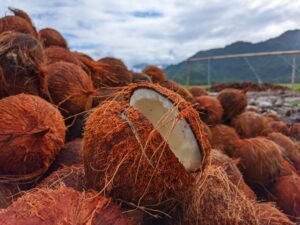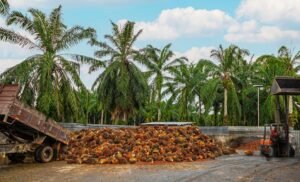
Husked Coconut Grades: How Indian Exporters Classify for Quality

The Importance of Husked Coconut Grades in Global Trade
Husked coconut grades are key to the coconut export business as they indicate the importer of what they are purchasing, and provide predictability in large volume shipments. Indian coconut exporters use well-defined grading practices that align with international market expectations. These systems allow buyers to order confidently based on consistent quality, size, and maturity.
As India remains one of the largest suppliers of export-quality coconuts, this grading standard has become vital. When importing coconuts for retail or processing, buyers require homogeneous batches in terms of appearance, weight, and shelf life. Defined grading categories help trade, minimize rejections, and help to develop trust between exporters and overseas distributors.
As India remains one of the largest suppliers of export-quality coconuts, this grading standard has become vital. When importing coconuts for retail or processing, buyers require homogeneous batches in terms of appearance, weight, and shelf life. Defined grading categories help trade, minimize rejections, and help to develop trust between exporters and overseas distributors.
Standard Husked Coconut Grades Used in India
Indian exporters classify husked coconuts into commercial grades that are easy to identify and trade. These grades are determined primarily by weight, shell appearance, and overall maturity. The goal is to match buyer needs, whether for retail display, oil production, or copra processing. Typical Grades Include:
Grade A (Premium Grade):
Grade A (Premium Grade):
- Weighs over 500g
- Fully mature with thick white meat
- Ideal for retail and direct consumption
- 450g to 499g
- Slightly thinner shell and moderate maturity
- Suited for general use and small-scale retail
- Below 450g or with minor surface flaws
- Typically used for oil extraction or food processing
These grades help exporters cater to different use cases, ensuring buyers receive the appropriate quality for their business operations.
How Indian Exporters Grade Husked Coconuts
Husked coconuts are graded shortly after harvesting and then continue to be graded at various points at the exporter’s facility. Sorting begins at the farm, where off or damaged nuts are removed. These coconuts are then taken to a grading station, where quality control officers check each of the nuts.
At this stage, they assess the size, moisture content, and finish of the outer shell. The use of moisture meters and weighing scales is also objective in the classification process. Exporters typically use a mixture of manual and semi-automated grading systems to classify coconuts by grade. The coconuts are subsequently packed according to grade, so that each export lot is homogeneous.
At this stage, they assess the size, moisture content, and finish of the outer shell. The use of moisture meters and weighing scales is also objective in the classification process. Exporters typically use a mixture of manual and semi-automated grading systems to classify coconuts by grade. The coconuts are subsequently packed according to grade, so that each export lot is homogeneous.
Buyer Preferences Based on Grade and Region
Buyers from different countries have specific preferences when sourcing husked coconuts, and Indian exporters tailor their grading accordingly.
Key Regional Preferences:
Key Regional Preferences:
- Middle East: Prefers Grade A coconuts with high shelf appeal and full maturity.
- Europe: Demands certified, moisture-tested coconuts with traceable grading documentation.
- Southeast Asia: Accepts mixed-grade batches for flexible usage in food and beverage industries.
- Industrial Buyers (Worldwide): Opt for Grade B or C for use in copra, oil, or coconut-based products.
Exporters must match these grade expectations while also meeting packaging and documentation standards for each destination market.
Ensuring Quality and Compliance Through Grading
Grading is not only a matter of selection but also of complying with quality standards, meeting the importing country’s quality regulations. Indian coconut exporters conduct batch testing, visual inspections, and quality assurance audits to maintain consistency. They also retain grading logs and supply visual samples when requested by the buyer.
Some exporters have begun using advanced technologies such as AI-powered image recognition and moisture analysis tools to streamline quality control. This helps eliminate human error and offers scalable solutions for large shipments. In the global trade of coconuts, where delays or mismatches can be costly, consistent grading helps maintain brand reputation and long-term buyer trust.
Some exporters have begun using advanced technologies such as AI-powered image recognition and moisture analysis tools to streamline quality control. This helps eliminate human error and offers scalable solutions for large shipments. In the global trade of coconuts, where delays or mismatches can be costly, consistent grading helps maintain brand reputation and long-term buyer trust.
Documentation that Supports Grading Clarity
Documentation is a critical component of husked coconut export, especially for graded shipments. It helps ensure transparency for the buyer and smooth customs clearance across ports.
Grading-Related Documents Often Include:
Grading-Related Documents Often Include:
- Grading certificates or weight classification slips
- Pre-shipment inspection reports
- Moisture content test results (for food-grade coconuts)
- Photographic references of each grade
- Full packing list detailing grade distribution per container
These documents are prepared in advance and shared with buyers as part of the export file. They support buyer confidence and protect against disputes in case of quality issues post-arrival.
Clarity in Grading Builds Buyer Trust
The process of grading husked coconuts is more than a technical routine; it’s a key part of India’s edge in the global coconut trade. By offering well-defined husked coconut grades, Indian exporters help international buyers streamline their procurement, reduce quality inconsistencies, and meet end-user expectations effectively.
With grading systems that combine traditional know-how and modern tools, exporters in India continue to lead with consistency, speed, and quality. For buyers looking to import coconuts at scale, understanding these grades makes it easier to plan, purchase, and deliver with confidence.
With grading systems that combine traditional know-how and modern tools, exporters in India continue to lead with consistency, speed, and quality. For buyers looking to import coconuts at scale, understanding these grades makes it easier to plan, purchase, and deliver with confidence.
Lorem ipsum dolor sit amet consectetur.
Lorem ipsum dolor sit amet consectetur. Consequat vulputate convallis eget mollis viverra nunc mi egestas. Risus facilisi nullam donec.


